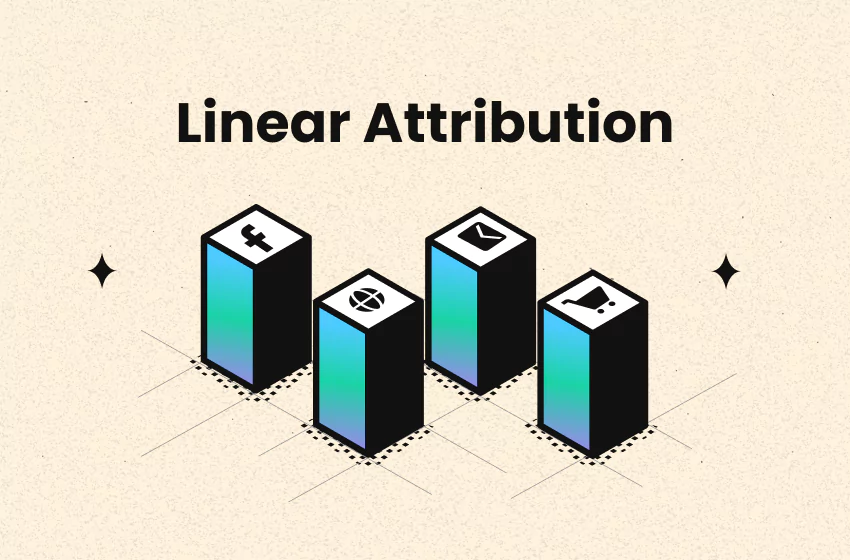Linear Attribution: How It Works & When to Use It (2025)

Are you struggling to understand how to accurately measure the impact of each touchpoint in your marketing campaigns? Linear attribution might be the solution you're looking for. In this guide, we’ll break down what linear attribution is, how it works, and how it compares to other models. Whether you're new to attribution or need a refresher, we’ll also provide real-world examples, pros, cons, and insights on when to use this model.
What Is Linear Attribution?
Linear attribution is a multi-touch attribution model that distributes credit equally across all touchpoints in a customer's journey before conversion. Unlike last-click attribution, which assigns 100% of the credit to the final interaction, linear attribution values every interaction equally, providing a broader view of how multiple marketing efforts contribute to a sale.
For example, if a customer interacts with an ad, an email, and a blog post before making a purchase, each channel receives equal recognition for the conversion. This model is especially useful for businesses with longer sales cycles and multi-channel marketing strategies.
How Does Linear Attribution Work? (With Examples)
Linear attribution tracks and assigns equal weight to every marketing interaction leading to a conversion. Let’s break it down with a real-world scenario.
Example: eCommerce Purchase Journey
A potential customer follows these touchpoints before making a purchase:
- Clicks on a Facebook ad
- Receives and opens a marketing email
- Reads a blog post on the company’s website
- Clicks on a Google Search ad and completes the purchase
Under linear attribution, each of these four touchpoints gets 25% of the conversion credit. This ensures that both top-of-funnel efforts (blog, ads) and bottom-of-funnel efforts (email, paid search) are accounted for fairly.
After calculating the credits, you can start to analyze and examine the results to identify touchpoints that consistently receive higher or lower credit and evaluate their role during the conversion process. To truly understand their impact on your bottom line, consider running the numbers through a profit margin calculator to see how each channel contributes to overall profitability.
Pros and Cons Of Linear Attribution
Besides various advantages, there are also significant disadvantages when it comes to the linear attribution model.
✅ Pros | ❌ Cons |
|
|
Linear Attribution vs. Last-Click Attribution
Many marketers compare linear attribution with last-click attribution since both models have distinct use cases.
Feature | Linear Attribution | Last-Click Attribution |
Credit Distribution | Equal across all touchpoints | 100% to the last touchpoint |
Best For | Multi-channel marketing, longer sales cycles | Quick conversions, direct-response campaigns |
Limitations | Overvalues minor interactions | Ignores earlier touchpoints |
While last-click attribution is simple, it often leads to misleading insights for businesses that rely on multiple touchpoints. In contrast, linear attribution is more balanced but might still lack precision in weighting each interaction’s true impact.
Does Google Ads Support Linear Attribution?
Yes. Google Ads provides linear attribution as an option, along with several other attribution models. However, data-driven attribution (DDA) has become the default for Google Ads, offering a more dynamic and AI-driven approach to crediting conversions.
Marketers using Google Ads can still manually select linear attribution in their account settings if they want a more balanced distribution of credit across multiple touchpoints.
When Should You Use Linear Attribution?
Linear attribution works best in specific scenarios, including:
- Multi-Channel Campaigns – If your business uses a mix of paid ads, email marketing, social media, and SEO, linear attribution ensures all channels get fair recognition.
- Longer Customer Journeys – For industries like B2B SaaS or high-ticket eCommerce, where multiple interactions happen before a conversion, this model helps track engagement more accurately.
- Brand Awareness & Nurturing Campaigns – If your marketing strategy focuses on nurturing leads over time, linear attribution helps measure the combined impact of all efforts.
Linear attribution is a solid choice for marketers who want a balanced, multi-touch view of their conversions. It works well for businesses with longer sales cycles and diverse marketing strategies but may not be the best fit for direct-response campaigns or businesses that need more precise attribution weighting.
After calculating the credits, you can start to analyze and examine the results to identify touchpoints that consistently receive higher or lower credit and evaluate their role during the conversion process. To truly understand their impact on your bottom line, consider running the numbers through a profit margin calculator to see how each channel contributes to overall profitability.
Leah Tran is a Content Specialist at TrueProfit, where she crafts SEO-driven and data-backed content to help eCommerce merchants understand their true profitability. With a strong background in content writing, research, and editorial content, she focuses on making complex financial and business concepts clear, engaging, and actionable for Shopify merchants.






![Time Decay Attribution Model: What It Is, Pros & Cons [2025]](https://be.trueprofit.io/uploads/time-decay-attribution-68931b1ee8064.webp)

![Ultimate Guide To U Shaped Attribution Model [+Example]](https://be.trueprofit.io/uploads/U-Shaped-Attribution-Model.png)
![The Ultimate Guide To Cross Channel Attribution [2024]](https://be.trueprofit.io/uploads/shopify-cost-of-goods-sold-definition-formula-how-to-track-2-68931b1aad5fb.webp)

![Data-Driven Attribution Model: How It Works & How to Set It Up [2025]](https://be.trueprofit.io/uploads/Data-Driven-Attribution_-Leveraging-Analytics-for-Better-Marketing-Decisions.png)
 Shopify profits
Shopify profits


